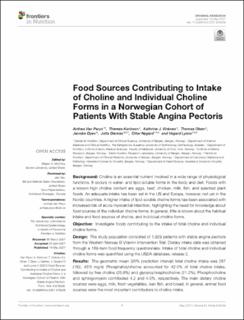| dc.description.abstract | Background: Choline is an essential nutrient involved in a wide range of physiological functions. It occurs in water- and lipid-soluble forms in the body and diet. Foods with a known high choline content are eggs, beef, chicken, milk, fish, and selected plant foods. An adequate intake has been set in the US and Europe, however, not yet in the Nordic countries. A higher intake of lipid-soluble choline forms has been associated with increased risk of acute myocardial infarction, highlighting the need for knowledge about food sources of the individual choline forms. In general, little is known about the habitual intake and food sources of choline, and individual choline forms.
Objective: Investigate foods contributing to the intake of total choline and individual choline forms.
Design: The study population consisted of 1,929 patients with stable angina pectoris from the Western Norway B Vitamin Intervention Trial. Dietary intake data was obtained through a 169-item food frequency questionnaire. Intake of total choline and individual choline forms was quantified using the USDA database, release 2.
Results: The geometric mean (95% prediction interval) total choline intake was 287 (182, 437) mg/d. Phosphatidylcholine accounted for 42.5% of total choline intake, followed by free choline (25.8%) and glycerophosphocholine (21.2%). Phosphocholine and sphingomyelin contributed 4.2 and 4.5%, respectively. The main dietary choline sources were eggs, milk, fresh vegetables, lean fish, and bread. In general, animal food sources were the most important contributors to choline intake.
Conclusion: This study is, to the best of our knowledge, the first to assess the intake of all choline forms and their dietary sources in a European population. Most choline was consumed in the form of phosphatidylcholine and animal food sources contributed most to choline intake. There is a need for accurate estimates of the dietary intake of this essential nutrient to issue appropriate dietary recommendations. | en_US |

